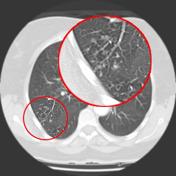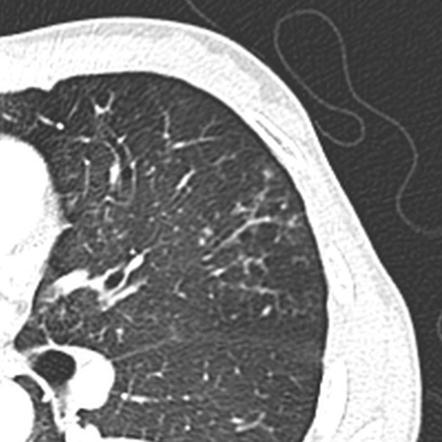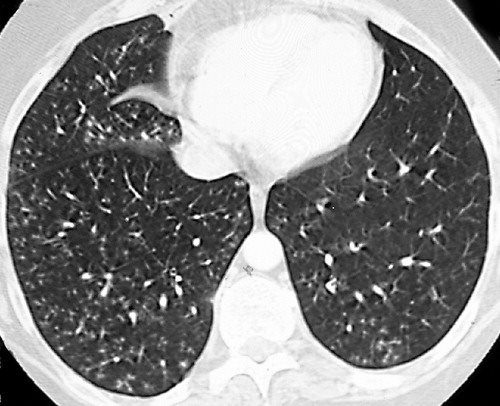tree in bud opacities in lungs
2 However the classic cause of tree-in-bud is Mycobacterium tuberculosis especially when it is active and contagious and associated with cavitary lesions. CT of the chest Figure 2B and 2C performed without the administration of intravenous contrast material revealed multifocal clustered.
Get prescriptions or refills through a video chat if the doctor feels.
. The tree-in-bud pattern suggests active and contagious disease especially when associated with adjacent cavitary disease within the lungs. However to our knowledge the relative frequencies of the causes have not been evaluated. We here describe an unusual cause of TIB during the COVID-19 pandemic.
Not only are these patterns difficult to detect but micro-nodules and other normal and abnormal structures have strong shape and appearance similarities with existing structures in the lungs. Tree-in-bud refers to a pattern seen on thin-section chest CT in which centrilobular bronchial dilatation and filling by mucus pus or fluid resembles a budding tree. The tree-in-bud sign is a nonspecific imaging finding that implies impaction within bronchioles the smallest airway passages in the lung.
TIB opacities are also associated with bronchiectasis and small airways obliteration resulting in mosaic air trapping. A young male patient who had a history of fever cough and respiratory distress presented in the emergency department. Tree-in-bud sign lung Tree-in-bud sign or pattern describes the CT appearance of multiple areas of centrilobular nodules with a linear branching pattern.
Board-certified doctor 247 in less than one minute for common issues such as. There are many technical obstacles to detecting complex shape patterns such as tree-in-bud that are associated with pulmonary infections. 02 P 0029 in Mycobacterium abscess lung disease.
High-resolution CT scan. In radiology the tree-in-bud sign is a finding on a CT scan that indicates some degree of airway obstruction. 3 2005 Tumor emboli from Ewing sarcoma in a 16-year-old boy.
Originally reported in cases of endobronchial spread of Mycobacterium tuberculosis this. Ad Plain English Explanation On The First Sign Of Lung Cancer. A significant difference of the lung area involved by tree-in-bud in CT was found between non-Mycobacteria abscess and Mycobacterium abscess lung disease 170 vs.
Causes for TIB opacities were established in 166 of 406. Get the Latest On The First Signs of Lung Cancer In This Article. Mycobacterium avium complex is the most common cause in most series.
Although initially described in patients with endobronchial tuberculosis it is now recognized in a large number of conditions. A tree-in-bud pattern of centrilobular nodules from metastatic disease occurs by two mechanisms. This includes fungalinfections mycobact.
The tree-in-bud pattern is commonly seen at thin-section computed tomography CT of the lungs. 1 2 3 4 Reported causes include infections aspiration and a variety of inflammatory conditions. The tree-in-bud-pattern of images on thin-section lung CT is defined by centrilobular branching structures that resemble a budding tree.
Respiratory infections cause about 72 of cases with 39 due to Mycobacterial cases 27 due to other bacteria and 3 due to viruses. The most common CT findings are centrilobular nodules and branching linear and nodular opacities. The differential for this finding includes malignant and inflammatory etiologies either infectious or sterile.
TIB opacities represent a normally invisible branches of the bronchiole tree 1 mm in diameter that are severely impacted with mucous pus or fluid with resultant dilatation and budding of the terminal bronchioles 2 mm in diameter1 photo. 3 found that the tree-in-bud pattern was seen in 256 of the CT scans in patients with bronchiectasis. We investigated the pathological basis of the tree-in-bud lesion by reviewing the pathological specimens of bronchograms of normal lungs and contract radiographs of the post-mortem lungs manifesting active.
Alternating areas of normal lung with regions of small airways disease TIB opacities bronchiectasis random small airways pattern was specific 092 for Mycobacterium. However to our knowledge the relative frequencies of the causes have not been evaluated. These small clustered branching and nodular opacities represent terminal airway mucous impaction with adjacent peribronchiolar inflammation.
1 direct filling of the centrilobular arteries by tumor emboli and 2 fibrocellular intimal hyperplasia due to carcinomatous endarteritis. It consists of small centrilobular nodules of soft-tissue attenuation connected to multiple branching linear structures of similar caliber that originate from a single stalk. Bronchiectasis which may be of any cause can produce the tree-in-bud pattern.
72 P 0001 and tree-in-bud occurred more readily unilaterally 212 vs. 1 5 6 7 8 9 10 11 12. The tree-in-bud pattern is commonly seen at thin-section computed tomography CT of the lungs.
11 TIB opacities represent a central imag- Background. Tree-in-bud TIB opacities are a common imaging finding on thoracic CT scan. Tree-in-bud TIB appearance in computed tomography CT chest is most commonly a manifestation of infection.
Rossi SE et al Tree-in-Bud Pattern at Thin-Section CT of the Lungs. HealthTap doctors are based in the US board certified and available by text or video. Although initially described in 1993 as a thin-section chest CT finding in active tuberculosis TIB opacities are by.
Multiple causes for tree-in-bud TIB opacities have been reported. As in this case renal cell carcinoma is one of the most common malignancies that may produce this vascular cause of tree-in-bud pattern. 69 P 0029 and in the inferior lobe of the right lung 32 vs.
Multiple causes for tree-in-bud TIB opacities have been reported. High-resolution CT scans show enlarged and beaded subsegmental arteries in the lower lobes. These small clustered branching and nodular opacities represent terminal airway mucous impaction with adjacent peribronchiolar inflammation.
Tree-in-bud TIB opacities are a common imaging finding on thoracic CT scan. Nodular opacities with tree-in-bud appearance can be associated with other changes in lung parenchyma-such as thickening of the bronchial walls consolidations andor areas of. Colds and coughs stomach symptoms bladder infections rashes and more.
Radiologic-Pathologic Overview RadioGraphics Vol. Computerized detection of tree-in-bud pattern. Another important entity that can produce the tree-in-bud pattern is bronchioalveolar carcinoma BAC 1.
The tree-in-bud sign is a nonspecific imaging finding that implies impaction within bronchioles the smallest airway passages in the lung. Usually somewhat nodular in appearance the tree-in-bud pattern is generally most pronounced in the lung periphery and associated with abnormalities of the larger airways. It consists of small centrilobular nodules of soft-tissue attenuation connected to multiple branching linear structures of similar caliber that originate from a.
Video chat with a US. In radiology the tree-in-bud sign is a finding on a CT scan that indicates some degree of airway obstruction. Note the peripheral tree-in-bud opacities.

Ct Scan Of Chest Revealing Scattered Tree In Bud Opacities In Both Download Scientific Diagram

Tree In Bud Sign And Bronchiectasis Radiology Case Radiopaedia Org

Tree In Bud Sign Lung Radiology Reference Article Radiopaedia Org

Tree In Bud Sign Lung Radiology Reference Article Radiopaedia Org

Tree In Bud Sign Lung Radiology Reference Article Radiopaedia Org
View Of Tree In Bud The Southwest Respiratory And Critical Care Chronicles

Pdf Tree In Bud Semantic Scholar
View Of Tree In Bud The Southwest Respiratory And Critical Care Chronicles

Scielo Brasil Tree In Bud Pattern Tree In Bud Pattern

Tree In Bud Pattern Pulmonary Tb Eurorad

Tree In Bud Sign And Bronchiectasis Radiology Case Radiopaedia Org



